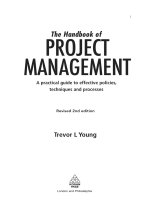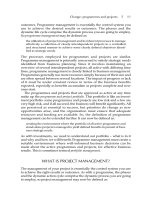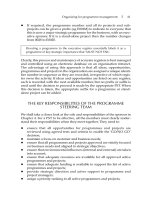CASE STUDIES IN PHARMACEUTICAL PROJECT MANAGEMENT: A TECHNICAL FORUM potx
Bạn đang xem bản rút gọn của tài liệu. Xem và tải ngay bản đầy đủ của tài liệu tại đây (2.99 MB, 4 trang )
The Authority on Drug Development & Manufacturing
PharmTech.com
2012
Supplement to the February 2012 Issue of
PREFERRED
PROVIDERS
Finding the
Right Partner
s2
Pharmaceutical Technology
PREFERRED PROVIDERS 2012 PharmTech.com
Project Management
P
roject management underpins successful relation-
ships between contract technology and service pro-
viders and their sponsor companies. As pharmaceuti-
cal companies increase their level of outsourcing, it
becomes increasingly important for contract technology and
service providers to provide not only the technical capabili-
ties needed to execute a given project, but the management
skills to deliver a project on time, to specifications, and with
the necessary communication to prevent or mitigate project
delays. To illustrate the importance of project management in
outsourcing, several industry members provided case studies
on how to coordinate, organize, and implement a successful
project.
Blow/fill/seal manufacturing
Norman Weichbrodt, strategic account manager at Catalent
Pharma Solutions
Catalent Pharma Solutions is a provider of drug and biologic
development services, delivery technologies, and supply so-
lutions. Effective project management is the cornerstone of
being a complete provider of services ranging from devel-
opment of new products to technical transfer of existing
products. Building the proper project team and employing
the correct methodology for handling a complex project is
the foundation on which success is achieved.
In July 2010, Catalent was approached by a major pharma-
ceutical customer to transfer an ophthalmic product approved
for sale in Europe to Catalent’s blow/fill/seal (BFS) manufac-
turing site in Woodstock, Illinois. The successful technical
transfer of the manufacturing process for this product would
potentially lead, following FDA approval of the product al-
ready made in the European facility, to approval of the drug
for manufacture and sale in the United States.
Project scope. The actual scope of this project was much
larger for the Woodstock facility than a simple technical
transfer. The project required the following:
•A complete renovation of a formulation and filling suite,
including a new separate air-handling system
Case Studies in Pharmaceutical
Project Management
A Technical Forum
Moderated by Patricia Van Arnum
Effective project management is an invaluable
competency in a successful outsourcing
relationship.
GREGOR SCHUSTER/GETTY IMAGES
•Designing, building, and qualifying an automated for-
mulation skid
•Upgrading an existing BFS filling machine to match the
capacity requirements for the product
•Designing, building, and qualifying new vial molding
and filling systems to duplicate the existing European
design
•Qualifying the room, formulation skid, BFS machine,
and secondary packaging to produce stability and
process-validation batches to support the customer’s
submission and approval timeline
•Developing and approving the required documentation
for supply-chain, manufacturing, and quality assurance
functions to meet the production timeline
•Analytical-method transfer for chemistry and microbial
testing
•Complete process-validation protocols, test plans, and
final reports to meet the submission timeline.
Cross-functional teams. To manage a project of this scope,
the Catalent New Product Development (NPD) group
and the site-management team agreed to form a group of
cross-functional resources. The team members served as
the primary representative of their functional area for the
project and were assigned for the duration of the project.
The project team consisted of a project manager from NPD,
an engineering project manager, a development scientist,
an operations specialist, a validation specialist, a quality-
assurance product specialist, a technical writer, and various
contract resources as required. A strategic account man-
ager had overall responsibility for the project team. The
establishment and use of an expanded core project team of
cross-functional resources was a new approach for Catal-
ent’s Woodstock facility, but the scope and timeline for this
project and the Catalent goal of meeting customer needs
required an innovative solution.
The project was divided into six major activities: the
room, the formulation skid, the BFS machine, method
transfer, secondary packaging, and documentation. The
NPD project manager was the owner of the overall project
timeline. Each major activity was included in a Microsoft
project schedule and maintained by the project manager.
The engineering project manager handled all activities in-
volving the renovation of the filling suite, making use of
contractors from design through construction and qualifi-
cation. He also participated in the design and construction
of the formulation skid, primarily focusing on the software
development. The development scientist and the opera-
tions specialist focused on the design of the formulation
skid and the interface of the skid with the BFS machine to
ensure the system had the proper design and controls to
replicate the process already being used in Europe. The
validation specialist developed the installatoin qualifica-
tion, operational qualification), and product qualification
protocols and had oversight of all factory acceptance test-
ing (FAT) and site-acceptance (SAT) activities. The tech-
nical writer and the quality-assurance product specialist
worked with the NPD project manager to manage the
change-control process for the project and to complete all
the required documentation, including material specifica-
tions, standard operating procedures, and manufacturing
batch records. The NPD Project manager also provided
oversight of the analytical method transfer, development
of secondary packaging materials, and the documentation
of project activities.
Technology transfer. The technology-transfer process was
initiated by creating a comparability document that detailed
every aspect of the manufacturing process. The process used
in the European manufacture was listed step by step in the
document with Catalent’s suggestions and capabilities side
by side. A final agreement for each step was included and
served as the approved path forward. The specifications for
in-process testing at each stage of the formulation as well as
finished-product specifications were included in the docu-
ment. The formulation process required bulk sterilization
of a multicomponent polymer base with a relatively tight
viscosity range. Two APIs were combined in a second part
of the formulation and transferred to the polymer solution
by sterile filtration. Of course, the entire formulation skid
required steam sterilization of the product path through
the BFS machine and maintenance of the sterile boundaries
for the product during the entire filling process. Electronic
documentation of all temperatures, times, and controls for
each process step also were also required.
Communication. The NPD project manager and the stra-
tegic account manager facilitated weekly calls with the
original equipment manufacturers of the formulation and
BFS equipment as well as construction meetings during that
phase of the project. Weekly calls were held with the cus-
tomer representatives who were in liaison with the project
team. A standard methodology was used to ensure that the
meetings had a structured agenda and minutes issued for
review in a timely fashion. A joint Project Steering Com-
mittee was formed, which was comprised of customer senior
leadership members, Woodstock site leadership members,
and Catalent business-development members.
Project Steering Committee meetings were held every
three weeks during the course of the project. A formal pre-
sentation was made at each meeting to discuss progress
toward major milestones in the project plan. Strategic de-
cisions were discussed and developed through the Project
Steering Committee meetings, and the decisions were ulti-
mately made by the joint project team. This management
design reduced the cycle time for critical decision-making
between the customer and Catalent.
Pharmaceutical Technology
PREFERRED PROVIDERS 2012 PharmTech.com s3
An example of such decision mak-
ing was approval of a change to the
SAT/FAT strategy originally planned
for the formulation skid. The formu-
lation skid is a fully automated two-
tank system with over 100 control and
process valves that are actuated in ap-
proximately 20 sequences. When the
software development lagged behind
the construction of the hardware, the
opportunity arose to do a mechani-
cal FAT, ship the formulation skid
to the Woodstock site, complete the
installation and mechanical trouble-
shooting of the skid and wait for the
software to complete the qualification
as a SAT. This decision saved as much
as six weeks in the project schedule
and enabled Catalent to meet the
customer’s timeline for stability and
process-validation manufacturing. It
also resulted in a formulation system
that is part of a robust technical trans-
fer process from the customer through
the NPD group to Catalent’s commer-
cial manufacturing team.
Execution. To date, all of the engineer-
ing, stability, and process-validation
batches have met the in-process and
final-product test specifications. With
nine batches produced, there have been
no out-of-specification results for bulk
or final product. In addition, no human
error deviations have occurred in the
formulation and filling of these batches.
Figures 1–3 (Catalent) show the fa-
cility upgrade and project equipment
after installation.
In summary, Catalent did not em-
ploy new or groundbreaking method-
ology for this project. However, supply-
ing the proper structure and resources
for a project team is the crucial first
step in meeting a customer’s timeline
and supplying the customer with qual-
ity product, reliably supplied.
Figure 1 (Catalent): A blow/fill/seal suite at Catalent’s Woodstock, Illinois, facility.
Figure 2 (Catalent): A blow/fill/seal cavity fill machine at Catalent’s Woodstock, Illinois,
facility.
Figure 3 (Catalent): A fully automated formulation skid at Catalent’s Woodstock,
Illinois, facility.
FIGURES 1-3 (CATALENT) ARE COURTESY OF THE AUTHOR
Project Management
Excerpted from and posted with permission from the Supplement to the February 2012 issue of Pharmaceutical Technology.
Copyright ©2012, an Advanstar publication. All rights reserved.
www.pharmtech.com
#C6545 Managed by The YGS Group, 800.290.5460. For more information visit www.theYGSgroup.com/content.









